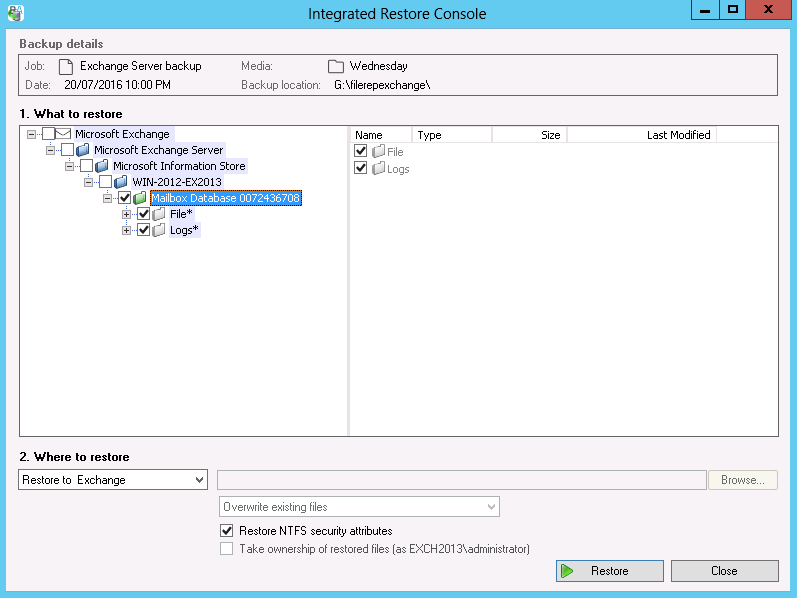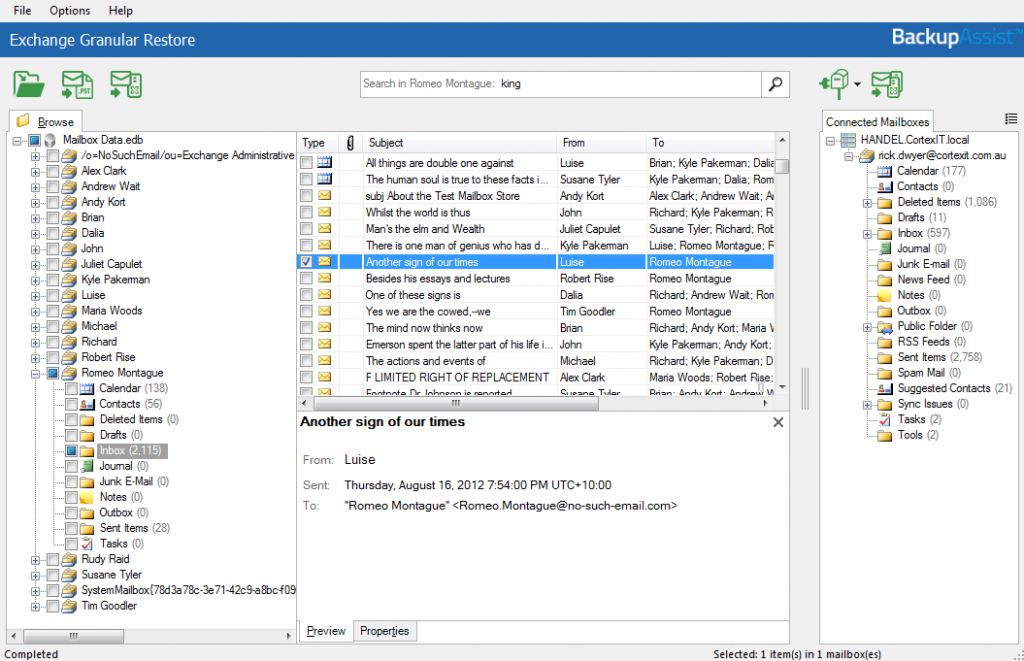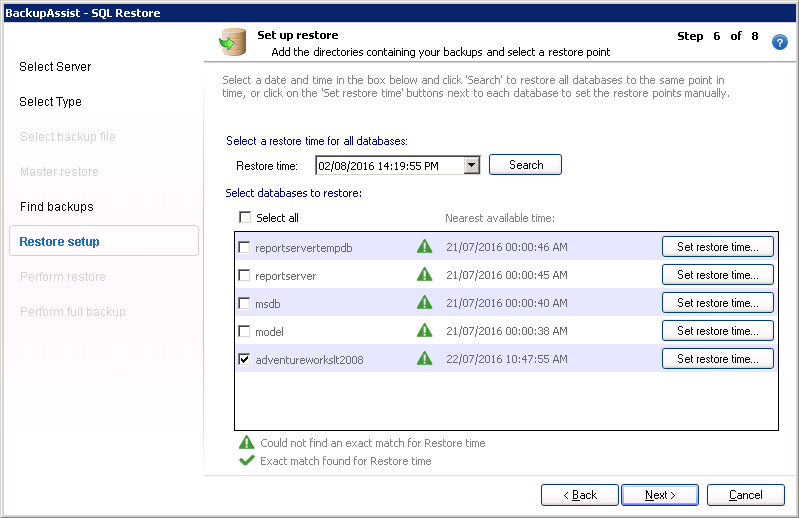
A backup is only as good as its recovery. Let's make your Windows Server recovery predictable and successful.
When a system goes down, everyone looks to you to restore operations. Whether it's a bare metal recovery or restoring some deleted files, surprises in high pressure situations are undesirable. What you need is a well-trodden path. The right tools and procedures help you rise to the challenge.
-
Restore and Recovery
◆◆◆
Technical Deep DiveWe identified 19 different ways to recover a Windows Server - from system bare metal recovery, to file version restore, to email restore. These scenarios may not be obvious until users start asking for their data from backup.
We want you to have all bases covered. The rich set of restore and recovery tools provided by BackupAssist, together with well-defined step-by-step guides, will put you in good stead.
- Well defined recovery scenarios with step by step instructions from our Recovery Bible
- Repeatable procedures and clear decision flow-chart to help guide you through the process
- The right tools to get the job done
Make sure everyone in the I.T. department can do the recovery, not just a single "guru".
- Organizations grind to a halt.
- High pressure situations for administrators.
- Jobs are on the line if a successful recovery is delayed or impossible.
- Cyber-criminals win by extorting ransoms from hapless victims who have no choice.
WHAT'S IN IT FOR YOU
Backups are useless if you can't get your data back.
So BackupAssist comes with the right tools and documented procedures to handle almost any restore and recovery situation you're likely to face.
And they're all documented in one handy book.
Here's a sneak peek at what's inside the Recovery Bible…
Full server recovery for physical servers:
1. Physical to Physical, Bare Metal Disaster Recovery (BMDR)
2. Physical to Virtual, Bare Metal Disaster Recovery
Full server recovery for Hyper-V environments:
3. Recover a Hyper-V Host and all guest VMs to new metal
4. Recover specific Hyper-V guest VMs to same host
5. Recover specific Hyper-V guest VMs to different host
File restore for physical machines:
6. Point-in-time search, browse and restore of files and directories
7. Search, browse and restore past versions of a file across all backups
File restore for Hyper-V guest VMs:
8. Point-in-time search, browse and restore of files and directories on a Guest VM from a backup of the host
9. Search, browse and restore past versions of a file on a Guest VM from backups of the host
Exchange Server restore and recover:
10. Recover entire Exchange Server from backup
11. Recover specific Exchange Database(s) from backup
12. Granular restore - specific mailboxes, emails, contacts, notes, etc. from a backup of Exchange in physical environment
13. Granular restore - specific mailboxes, emails, contacts, notes, etc. from a backup of Exchange in Hyper-V environment
SQL Server restore and recovery:
14. Full SQL Server recovery from a drive image or application backup
15. Point in time recovery of SQL databases
Restore without BackupAssist tools (only native Windows tools):
16. Restore from drive image backup
17. Restore from file replication backup
18. Restore from ZIP archiving backup
19. Restore from SQL backup

Try BackupAssist Classic to receive your free copy of the Recovery Bible and let's make your recoveries predictable and successful!
HOW IT WORKS
We provide 2 core tools, and 3 specialized tools to get the job done.

Core Tools
RecoverAssist
For bare metal recovery from image backup, in physical and virtual environments

Core Tools
Universal Restore Console
For granular data restore of files for physical server and hyper-v backups.

Specialized Tools
Exchange Granular Restore
For restoring specific items at granular level from a backup of the Exchange EDB file.

Specialized Tools
Hyper-V Rapid VM Recovery
For near-zero downtime for Hyper-V environments

Specialized Tools
SQL Point-in-time Restore
To restore SQL Server databases to a given point in time.
Let's get into the details of each tool.
FREQUENTLY ASKED QUESTIONS
What is bare metal recovery?
It's when you need to recover an entire system from a backup. Here's an example:
- Your server is destroyed by fire. You have an offsite drive image.
- You buy a new server.
- Somehow you need to get data off your drive image backup onto the new server. That's the process of bare metal recovery.
You'll follow the steps:
- Boot off your recovery media. You can either create a RecoverAssist bootable recovery media on a USB stick, or make your backup disk bootable.
- Connect your backup. RecoverAssist can search for USB connected drives, or find backups on a network share or iSCSI device.
- Perform configuration tasks for your new system, such as including new drivers.
- Kick off the recovery process.
You'll see many variations of names used in different places by different vendors. They generally mean the same thing! Here we go:
- Bare metal disaster recovery (BMDR)
- System recovery
- System restore (different from System State restore)
- Image backup recovery
No - although RecoverAssist is quite similar to Windows RE, it does not have the same problems. Let's delve deeper.
Depending on your version of Windows, you might experience different problems.
Under Windows RE, you may experience a “blue screen of death” (BSOD) after doing a bare metal recovery from drive image. This applies to all Windows versions, but especially for Windows Server 2008 and Server 2008 R2. The problem occurs when recovering to different hardware - if there is a mismatch between your storage device, the blue screen will occur. There can also be issues if you recover from physical to virtual.
RecoverAssist solves this problem by correctly instructing Windows to re-detect hardware devices after a reboot. RecoverAssist also allows you to include additional drivers in your Recovery Environment, and also to add drives at the time of your bare metal recovery.
This has the effect of giving you a successful and predictable recovery.
To restore deleted files, you'll use the Integrated Restore Console.
From here, you can search and browse your backups. The Integrated Restore Console will automatically attempt to connect to the correct backup to restore data, or if the backup is not already connected, it will tell you which backup media to connect (e.g. if it is a USB Hard Drive or Tape).





